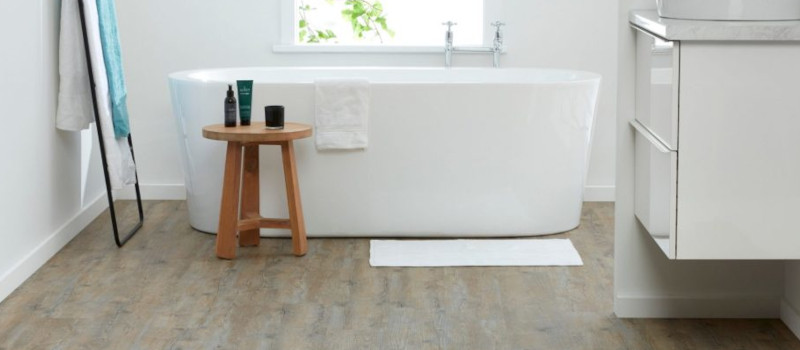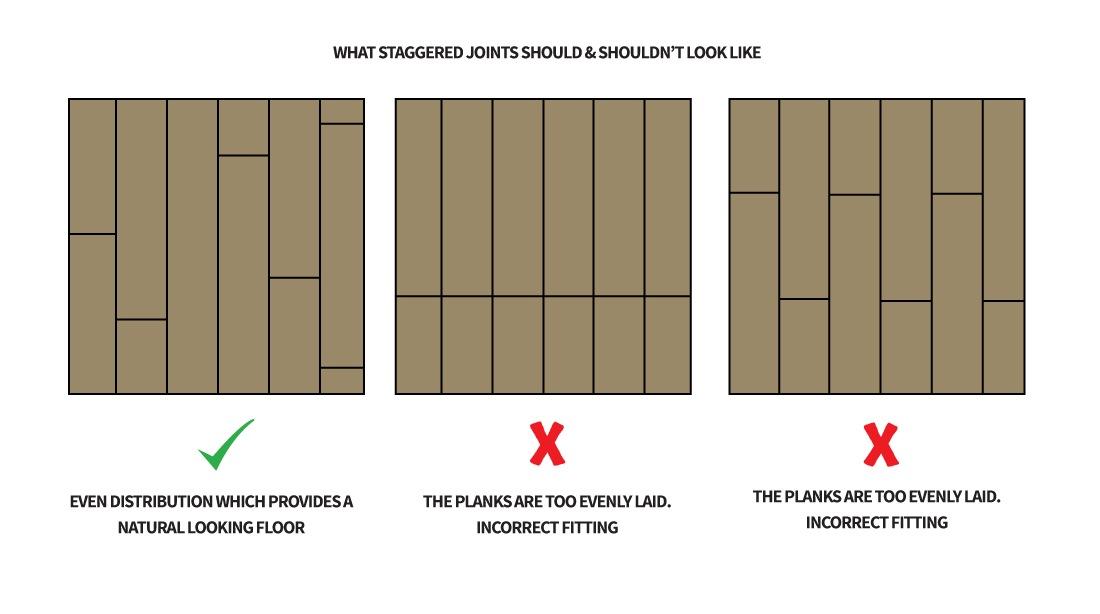SPC Flooring – What Is SPC Vinyl Flooring? | Home Flooring Pros
Stone Polymer Composite Flooring
SPC stands for stone polymer composite, a type of LVP/LVT flooring. It is called rigid core flooring because of the stiffness of the crushed stone core. SPC floors are produced to look like wood planks or stone tiles but are much more affordable than the “real thing.”
It is often compared to laminate flooring but with the advantage of being waterproof. Mostly used commercially, rigid core flooring is also ideal for any residential location where hardwood and other hard surface flooring is being considered.
Last Updated: July 6, 2023, by: Jamie Sandford
Here the Home Flooring Pros guide to SPC flooring, including pros and cons, prices, best uses, installation techniques, maintenance, and comparison to other popular flooring types – plus FAQs, everything to help you make an informed decision on your flooring purchase.

Let’s get started with the basics. We’ll define what SPC flooring is, what its made of, how its constructed and what its good for…let’s go!
SPC FLOORING INTRODUCTION
This flooring has a lot of names, because it is fairly new and the industry hasn’t settled on the “best” term for it.
After reading this page, you’ll be familiar with SPC construction and why it’s so durable, its cost, what it is good for and how it compares to other flooring materials you might be considering.
Stone plastic composite flooring includes several layers in its composition, each with a purpose.
WHAT DOES SPC STAND FOR?
What does SPC mean in flooring jargon?
SPC is short for stone polymer composite or stone plastic composite. The terms are interchangeable.
The term rigid core flooring describes its tough core formed from crushed stone, usually limestone.
And because it has a layer of quality vinyl, it is also termed rigid core luxury vinyl and rigid core vinyl flooring.
Finally, because it is constructed in layers, the term engineered vinyl flooring is used, or EVP, which stands for Engineered Vinyl Plank. We have an in-depth review of EVP flooring, including a look at the best EVP brands with pricing.
WHAT IS SPC FLOORING MADE OF?
As we’ve done when describing the construction of laminate flooring and LVT flooring, let’s take SPC from the top down and describe its layers.
1). The Wear Layer: The surface layer is a transparent, thin film of either aluminum oxide (more common) or a ceramic bead coating (slightly more durable and scratch-resistant).
SPC wear layer thickness ranges from 12 mils to 22 mils thick, with 1 mill = 1,000th of an inch. Thin but tough. Commercial SPC flooring has a wear layer up to 40 mils.
2). Clear Vinyl or Polyurethane: A thin coating of one of these materials is applied to the vinyl layer below it for added protection against deep scratches plus improved bonding of the wear layer.
3). The Luxury Vinyl Print Layer: This thin layer of premium vinyl – polyvinyl chloride – gives the flooring its appearance. A very realistic image of genuine hardwood plank or stone such as granite or marble is printed in full color onto this layer.
4). The Rigid Core: Usually made from crushed limestone, the stone core means the material can be thin and yet very tough. It provides these advantages:
- Strength,
- Stability
- Durability
- Waterproof performance
5). Optional Attached Pad: Most SPC luxury vinyl has foam (basic) or cork (better) padding attached as an underlayment to soften the material underfoot and also for sound absorption.
SPC PLANK AND TILE OPTIONS
This rigid core vinyl flooring is produced in luxury vinyl plank flooring and luxury vinyl tiles.
SPC planks mimic wood planks, of course. Plank sizes range from 5” to 10” wide, and most are around 48” long.
SPC tiles reproduce the look of stone tile, mostly, but some are designed to mimic ceramic or porcelain tile. Most are large format 12”x 24” tiles.
WHAT IS SPC FLOORING GOOD FOR?
This vinyl flooring was designed for waterproof durability. It is an improvement in both areas over a similar luxury vinyl flooring type – WPC vinyl flooring, aka wood composite flooring.
For residential use, stone plastic composite floors look good anywhere. They show their true benefits in two important locations:
- High-traffic areas like entryways, mud rooms and hallways.
- Any area that gets wet – yes, mudrooms and entryways, but also bathrooms, kitchen, laundry room and basements.
Further Reading: Best Vinyl Kitchen Flooring
PRO AND CONS
Every flooring has advantages and disadvantages. Here are the ups and downs of stone polymer composite floors.
PROS
Stronger than standard LVP and LVT – The stone core makes it very stable and durable. It is not susceptible to changes in humidity and temperature – it won’t swell or shrink or warp.
Waterproof – No organic materials are used, nothing to absorb water and cause swelling or other damage. The stone core is sealed.
Thinner than other luxury vinyl. This allows you to install SPC vinyl flooring over some flooring types rather than removing it first. And it creates fewer height problems when it butts to other materials.
DIY-friendly. The name click SPC is given to it to describe how easy it is to snap pieces together. They come apart pretty easily too in case you need to replace a damaged piece.
Scratch-resistant wear layer. It is equal to better grades of LVP and laminate in this regard.
Good selection. Like all luxury vinyl flooring, it is available in wood and stone looks and in a range of tones from light to very dark.
More affordable than real wood. You’ll save $4 to $12 per square foot with SPC vs real hardwood. Full pricing below.
CONS
What are the disadvantages of SPC flooring?
Hardness. It’s not harder than wood floors or tile, but it isn’t soft like standard LVP or carpeting. The attached pad does little to add comfort, especially if installed over concrete.
Not real green. Most SPC flooring is certified by FloorScore and/or GreenGuard to be low-VOC. That’s good. But while some manufacturers claim it is recyclable, close to 100% of it ends up in landfills.
Costs more than standard LVP. Expect prices of $1-$2 per square foot above LVP that isn’t rigid core luxury vinyl flooring.
Return on investment isn’t great. First, some home buyers still aren’t familiar with it. Secondly, if homes in your area mostly have genuine wood floors, buyers won’t be impressed with stone polymer composite flooring, despite its many virtues.
WHAT ARE THE DIFFERENCES BETWEEN SPC AND WPC?
The primary difference is that stone plastic flooring does not contain any wood material. Both WPC – wood plastic composite – and laminate do.
This is important because wood, when exposed to moisture for long enough, will absorb water. And when that happens, the flooring is ruined.
HOW MUCH WILL SPC FLOORING COST?
While still budget-friendly, SPC cost is above-average for luxury vinyl flooring options.
How much does SPC cost?
For an average room of 300 square feet, expect the installed cost to be $1,900 to $4,500 depending on the material you choose and how difficult the installation is.
An average range for good flooring and typical installation is $2,400 to $3,500 for 300 square feet.
How much is SPC flooring per square foot?
Cost is $3.35 to $11.00 per square foot. The most popular styles run $5.00 to $7.75 per square foot.
Factor in another $3 to $4 per square foot for pro installation.
Stone Plastic Composite Warranties
Most of this luxury vinyl flooring is backed by a lifetime warranty for residential use and a 5-year commercial warranty.
The warranty protects you if the flooring falls apart or separates – called delamination.
It doesn’t guarantee that the floor won’t wear out or that the wear layer won’t wear through in heavy traffic. In other words, you might very well want to replace the floor in 12-20 years because it looks well used, particularly in busy areas of your home.
SPC INSTALLATION
One of the advantages of stone polymer flooring is that it is easy to install, a common DIY project for handy homeowners.
The edges are designed similar to tongue and groove flooring, though on a smaller scale. They easily click or snap together.
You’ll need a chop saw to cut pieces – they’re tougher than standard luxury vinyl. And a table saw is handy for “ripping” planks and tiles, which is to cut them lengthwise for the first and last rows of flooring.
Further Reading: Best Way to Cut Vinyl Plank Flooring
Installation tips:
Stagger the planks or tiles so that butt ends of pieces next to each other are at least 4” apart. The ends should be random too.

Secondly, balance the room so that the rows against the side walls are roughly the same width. Divide the width of the room by the width of the plank. Then divide the remainder in half.
Or…hire a pro for $3.00 to $5.00 per square foot depending on room size, configuration, obstacles/trimming and other site factors.
Further Reading: Vinyl Plank Patterns
FAQs
How do you clean SPC floors?
Use a brushless vacuum or a soft broom to remove dust and loose dirt.
Sticky messes are best removed with a damp cloth. Spray on a little warm water and cleaner or water/white vinegar mix. Let it sit for a few minutes, and wipe it up.
Is SPC really waterproof?
Yes, the flooring is completely impervious to water. However, if your floor floods and water eventually gets through the seams into a wood subfloor, you’ll have serious damage.
It is guaranteed to be water against common spills that are cleaned up in a timely manner.
How long does rigid core flooring last?
SPC flooring lasts 15 to 25 years in most homes.
If traffic is very heavy, shoes are worn and the dirt/sand/debris is rarely removed, then the floor will look marred in under 10 years.
With normal care and precautions, expect 12-18 years in most rooms. In bedrooms and where a shoes-off policy is used, the flooring can look good for 20-25 years.
Is SPC the same as luxury vinyl?
It is a type of luxury vinyl along with standard LVP and LVT and WPC flooring. In short, it is luxury vinyl with a rigid core.
Can SPC be used in bathroom settings?
Yes. It’s waterproof design makes it an excellent choice for the bathroom and other rooms where the floor occasionally gets wet.
About the Author: Jamie Sandford
 Jamie Sandford is the Owner and Chief Editor of Home Flooring Pros (find out more). After 12 years’ experience in screen and stage set construction, followed by a further 15 years working in the home renovation/remodeling business, he now writes and curates online home improvement advice.
Jamie Sandford is the Owner and Chief Editor of Home Flooring Pros (find out more). After 12 years’ experience in screen and stage set construction, followed by a further 15 years working in the home renovation/remodeling business, he now writes and curates online home improvement advice.
“Buying and installing home flooring should be a fairly straightforward process, but often it isn’t. After more than 15 years experience in home flooring and remodeling, I started Home Flooring Pros in 2013 to help homeowners navigate the often-over complicated process of choosing, buying and installing a home floor. The aim is to save you time and money by helping you to make better floor buying decisions.”
